Players recall World Cup of Hockey euphoria, agony of 1996 and 2004
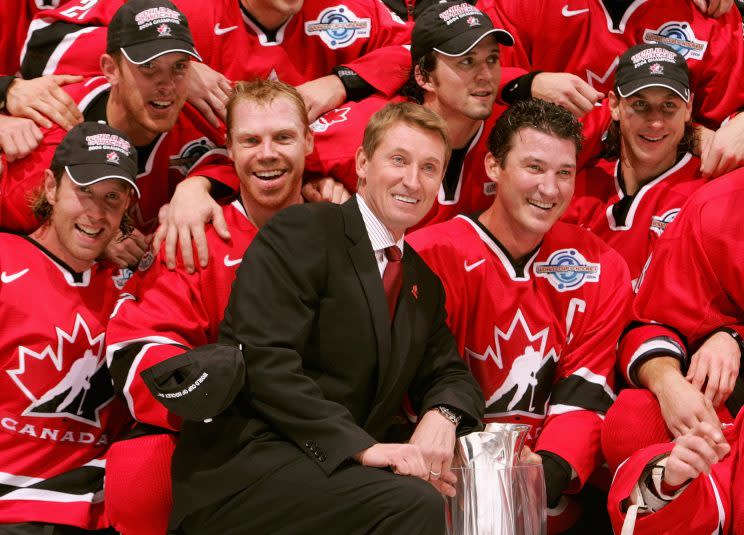
Joe Thornton received the puck on the boards behind the opposing net. He flicked it to teammate Shane Doan, who then waited – and waited – in front of Miikka Kiprusoff’s goal crease before ripping a shot over the outstretched Finnish netminder
It was Sept. 2004. It was a 3-2 lead for Team Canada in the World Cup of Hockey final. It was a chance for all the Canadian fans in Toronto to exhale.
“We started to breathe. It’s really … it’s intense. And the whole country is wanting you to win,” Hockey Canada CEO Bob Nicholson recalled of Doan’s eventual game-winner.
Eight years earlier in Montreal , Tony Amonte corralled a rebound off a shot from Derian Hatcher. He saw an opening in the Team Canada net and buried the puck past Curtis Joseph to give Team USA a 3-2 lead it would never relinquish in the World Cup final game.
The weight of that moment was equal Canada’s in 2004. The celebrations after the U.S.‘s 5-2 win were just as exuberant.
“It happened so quick in Game 3 in the last four minutes, we were on such a high,” Team USA Captain Brian Leetch said.
The 1996 World Cup was seen as a springboard for the NHL to introduce new stars in an international tournament. Several players used the preseason event as a high-level training camp to vault them into career years.
“I think it was a real confidence builder for all of us to win,” Team USA goaltender Mike Richter said. “There’s never a bad time to do that, whether it’s at the end of your career or the beginning but for some guys it was a real shot in the arm to a career that was good.”
The 2004 event had all the same ingredients, only it wasn’t a springboard into an NHL season. Because there was no NHL season: Thornton, for example, packed his bags after it was over and prepared to head to HC Davos in Switzerland.
Goodbyes to teammates lasted the whole year, as the 2004-05 lockout started two days after the World Cup and eventually wiped away the whole season.
“Everybody was in town for training camp, so we all skated together for the first probably two weeks after training camp, and then you’re thinking ‘how long is this going to last?’” Doan said.
The NHL and NHLPA are bullish on the upcoming World Cup of Hockey as a way to draw fan interest and help the bottom line for both the league and the players. When the top players in the world line up for their country, it’s generally a given that they’ll give their best. Also, the NHL has put in several measures to ensure that the tournament should pop.
Overall, the structure and model of the 2016 World Cup is based off some lessons from the prior two events in hopes that this will be closer to the 1996 tournament in terms of popularity than the 2004 World Cup.
Team USA in 1996
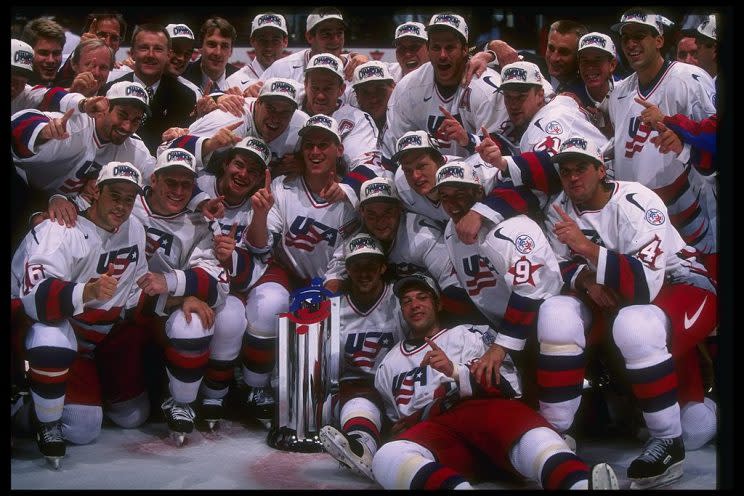
When Team USA players arrived in Providence, Rhode Island, for their pre-tournament camp, there was a sense of anticipation, familiarity and mystery.
They all knew each other from prior international tournaments. They all believed they had the talent to beat Canada, but it was tough for them to know how everyone would click.
Then the group hit the ice and the chemistry was apparent from the get-go.
“I can remember guys walking off the ice after that first practice and going, ‘that was the fastest practice I’ve ever been a part of,’” goaltender Mike Richter said. “Like for Brett Hull and other great players, normal drills weren’t so normal when you had that level of talent in one spot.”
The team was loaded with players entering their primes along with some new American blood. Keith Tkachuk – age 24 during the tournament – and Bill Guerin – age 25 at the World Cup – were remembered fondly as bringing skill and a certain tough-guy humor to the locker room.
“I think our immaturity brought the best out of everybody. Just typical Boston swagger I guess,” Tkachuk said. “We liked to have fun and were young at the time. I think it was one of those things where (Guerin) and I clicked pretty good together on and off the ice.”
Said Leetch, “You can’t force chemistry and you can’t force people getting along and wanting to be around each other. We could have gone through that same thing and gone out and played and, we could have done that same without having to be together, but we liked being around each other so that was kind of the extra at the end of it.”
There was little fanfare around the tournament in the United States before the event. Diehards knew about the World Cup but a lot of the focus from fans was still on the NHL teams.
“In the summer they just thought, it was just waiting for training camp and then the season to start,” defenseman Phil Housley said. “They didn’t really know there was a World Cup except for the hockey people. It wasn’t anybody saying, ‘good luck’ or anything like that because I just don’t think it was known that much.”
As the United States rolled through the North American pool, winning all three of their games, the public started to get more of a sense that the country could go deep in the tournament. Really, a lot of the fervor started when the U.S. beat Canada, 5-3 on Aug. 31 in Philadelphia.
Fans in the building pulled against Philadelphia Flyers superstar Eric Lindros, which struck a note with Team USA.
“Those first three games really boosted us, being able to play in Philadelphia and have that start against Canada with teammates going at each other and a fight with Tkachuk and (Claude) Lemieux and the Philly crowd rooting for the U.S. team and against Eric Lindros, even though how much Eric meant to his team in Philly. That crowd really was excited,” Leetch said.
Said Tkachuk, “First of all, it’s Philadelphia. You never know what to expect. You always expect the worst. They’re such passionate fans, they’re crazy and any time you walk into a building for myself, having that crowd behind me was incredible. And Eric Lindros was the face of the Philadelphia Flyers at the time so it was a bit strange but country first I guess. It was a great setting.”
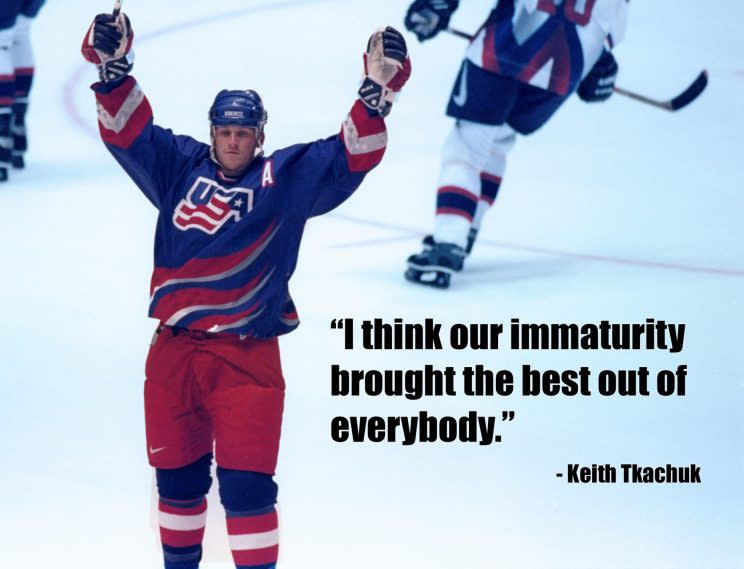
When the United States reached the final series against Canada and then lost the first game in OT, the stage was set for their comeback in Montreal.
The Americans took the first game, 5-2 on the strength of a two-goal performance by John LeClair and 35 saves by Richter.
In the final game in front of a crowd of 21,273 a chance at victory looked bleak for the Americans midway through the third period. At 12:50 Canadian defenseman Adam Foote fired a shot past Richter to give Canada a 2-1 lead. Then with 3:18 left Hull deflected a Leetch shot to tie the game at 2-2. Just 43 seconds later Amonte gave the Americans a 3-2 lead. Team USA beat Canada 5-2 in that final game.
If the U.S. had beaten Canada by sweeping both final games, American hockey fans may not have been as euphoric afterwards. But the series comeback and the final four minutes of the championship game made the win seem epic to a degree.
“I mean I think if you were a betting man you would have lost a lot of money on that because winning two games with that star-studded lineup they had in that hostile environment made it more sweeter,” Tkachuk said.
It had been 16 years since the 1980 Miracle on Ice, and the event gave U.S. hockey fans their first big, international victory since then. A lot of American stars were important parts of their NHL clubs but the World Cup pushed some other players from the U.S. further into the league spotlight.
Amonte scored 41 goals in his first of four straight years of 73-or-more points. Tkachuk set a career-high with 52 goals to lead the NHL. Mike Modano scored 35 goals and was a plus-43 in one of the finest all-around seasons of his career. Guerin set a career-high with 29 goals. Leetch’s 85 points were the third-most of his career and his highest total in the mid-90s ‘Dead Puck Era.’
“I just know a lot of guys were in the prime of their careers and that type of separation and shape you come into after four weeks of practicing and playing like that is you’re ready to go,” Leetch said. “You’re ready to go right from the start so it’s definitely understandable.”
Some players were celebrated when they returned home for the start of the regular season, which kept the positive public relations of the event alive for some time after the tournament’s completion.
“I remember they did a huge announcement for the guys that had won and Keith was on the ice,” Doan said of after Tkachuk returned to Phoenix. “It was only 16 years after the Miracle on Ice. No one called it that but there was a lot of talk about it how the U.S. came so far and how the best players in the U.S. could compete against anybody.
The group and the stars from that team became natural successors to the 1980 team as role models for American hockey players and youngsters. The U.S. Hockey Hall of Fame announced that the entire 1996 team would be inducted because of the importance towards the growth in hockey in the country.
“When you hear the stories about what went on in that room before big games and things like that, it’s pretty incredible. It actually would be a great movie,” 2016 Team USA World Cup general manager Dean Lombardi said. “Why not take advantage of our history? Certainly Canada does it all the time. Those guys gave us a pretty special history to take advantage of.”
Team Canada in 2004
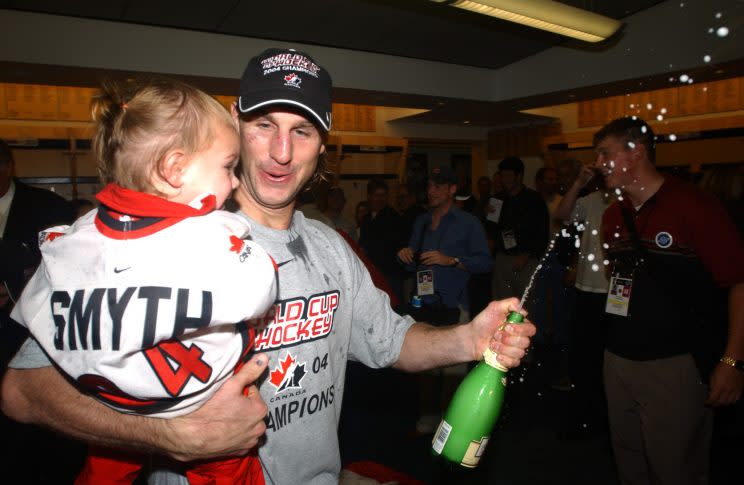
Thornton had watched the 1996 World Cup of Hockey as a junior player in his draft year and saw the high quality of play the tournament generated. When Team Canada asked him if he wanted to be a part of the 2004 squad, he showed no hesitation.
“When I got named to that team, I was pretty stoked,” Thornton said. “I was very, very excited. I played in the World Juniors, but this is a huge, huge tournament. This is my biggest tournament as far as Team Canada goes. It was huge for me to be a part of.”
The team had a mix of, legends, superstars and future stars such as Mario Lemieux, Scott Niedermayer, Joe Sakic and Martin Brodeur to go along with Thornton, Jarome Iginla, Martin St. Louis and Brad Richards. Steve Yzerman was initially named to the team, but was replaced by Vincent Lecavalier.
“We had so many names and great players. It was a phenomenal team,” Thornton said.
The Canadians had just won an Olympic gold medal two years earlier at Salt Lake City, and were the heavy favorite. A lot of the U.S. players who garnered national attention in 1996 had started to age. Some core players, such as Richter, who was the first World Cup tournament MVP, had retired. Richter’s retirement had specifically hit Team USA hard since he had been their starting goaltender in major international competitions during the 90s and early 2000s.
“I don’t want to be critical of anybody because I had retired. I think it was sort of a changing of the guard and I think that may be why there was some – because there were some younger players coming in,” Housley said.
The drop in the U.S. talent level made a final (and 2002 Olympic) rematch between the two North American hockey powers a longer-shot. Also, the looming NHL lockout, which was supposed to start two days after the tournament, hurt the marketing element of the event.
Instead of using the World Cup as momentum heading into the next season, it was viewed as the last event fans could watch NHL players before the work stoppage.
“I think a lot of us were hoping the buzz and the press would be really good and hockey would come out in a good light and would put more stress and pressure to get the lockout over with and get an agreement done,” said Team Canada forward Brenden Morrow.
“I was at the start of my career and was just looking forward to this event. I didn’t look past that. Maybe I was naïve – I thought that the lockout wasn’t going to happen and something would be done real quick and I was wrong about that.”
Players said they put the possibility of a lockout in the back of their heads and didn’t think about it during the tournament. It may have been a topic of discussion early on in the locker rooms, but ultimately it didn’t affect how they approached games.
“You heard all the talk like ‘it’s going to be long, it’s going to be long’ going into it but most of the guys hadn’t expected it to be as long and as hard as it was,” Doan said. “I don’t think you ever anticipated something like that.”
The Canadians used their depth up and down their lineup to squash the rest of the world in pool play. The team went 3-0-0 and outscored their opponents 10-3. They opened the event with a 2-1 win over the United States, then trounced Slovakia and Russia by a combined score of 8-2 in the next two games.
In the semifinal they won 4-3 in overtime over the Czech Republic on a goal Lecavalier, who was later named tournament MVP. This proved a punctuation mark on a year that saw him develop into a league star with a Stanley Cup victory months earlier.
Doan’s goal in the final ended the strong all-around, undefeated tournament by the favorites. Some people involved with the event believed Doan’s goal was almost as important as other famous Canadian goals in international play history.
“Everyone goes to Paul Henderson, Sidney Crosby, but this one certainly ranks up there in the top 5,” Nicholson said. “It’s great to see a player like Shane Doan scoring that goal because he really is a typical Canadian hockey player who plays both ends of the rinks.”
It was also the last major international event that included Lemieux, which provided fond memories for those involved after the tournament.
“Whenever I talk about it, the thing I talk about is Mario Lemieux that I got to play with Mario Lemieux and that was pretty cool,” Doan said.
“Mario had wore a pullover fleece the entire tournament. For every warm-up and after every warm-up, he’d walk around with this Team Canada pullover on. My brother was in the locker room after the tournament and all the family was in there … Mario had this fleece on and we were all celebrating and he pulled the fleece off so he threw it to my brother.
“I wanted to jump in and grab it but he got it. It’s one of those things I’ll never forget.
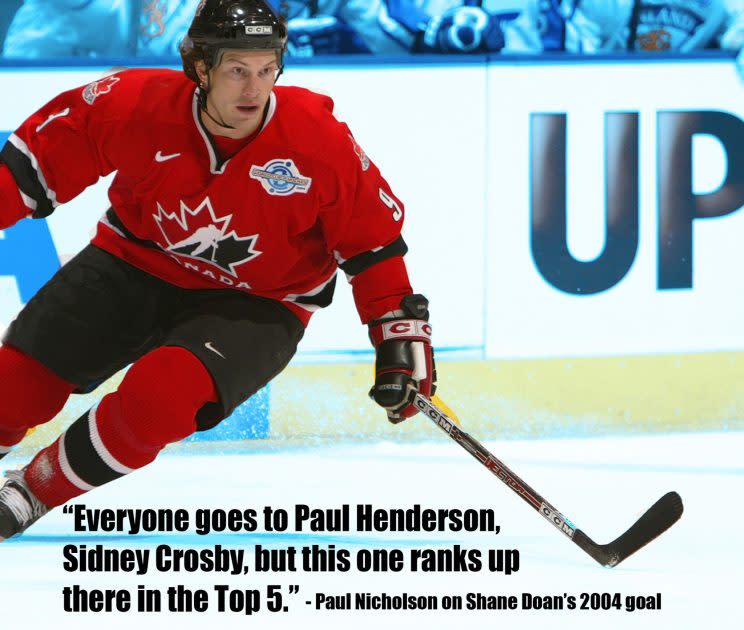
It was Canada’s also second straight major tournament victory with NHL players and the win helped the country continue to re-establish its dominance in the international realm. The players celebrated accordingly.
“I remember there was something written on the board about ‘next game’ or ‘time to beat this team.’ Then on the board there was no one left to beat,” Doan recalled.
Added Thornton, “We were excited. I remember going out that night and having a little bit of fun.”
After the tournament, some players joined their teammates in their NHL markets for some informal skates, thinking that a work stoppage would end at some point in the next month or two. Thornton quickly left for Switzerland, but didn’t think he would be there too long.
“At that stage of my career I wanted to play and I had to play. I just wanted to play, I didn’t care where I played,” he said.
But what should have been a proud moment for hockey and Team Canada supporters was ultimately shrouded by pending work stoppage that eventually cost the league and its players an entire year.
“Everyone was sitting there saying, ‘well the lockout is starting in two days,’” Team USA senior director of hockey operations Jim Johannson said. “There wasn’t that excitement on ‘what a way to kick off the season. In 2004 I never once heard anybody say, ‘wow, what a great way to start the season.’ It was all ‘at least we get a little hockey because there’s no hockey after this thing.’”
Though a lot of Canadians fondly remember Doan’s goal, some Team Canada members have forgotten it completely.
“I don’t remember that one at all,” Morrow said.
When asked why he had no memories of the goal, Morrow pointed out that at that on top of the lockout talk there may have also been some international tournament fatigue. Between the 1996 World Cup, the Olympics in 1998 and 2002 and then this event, a lot blended in together.
“I would just say that I think the World Cup has lost maybe some of its luster. It was not an event that happens consistently every four years. It was on, it was off,” Morrow said.
“I know a lot of my friends, not really fully engaged in hockey but have become hockey fans now – they don’t really know what that tournament is or what it’s about. I think you remember the Olympics and the Stanley Cup. They are consistent events. This thing isn’t realized by the mass of hockey fans.”
Can that change?
“I think they’re doing everything they can,” Morrow said.
World Cup 2016
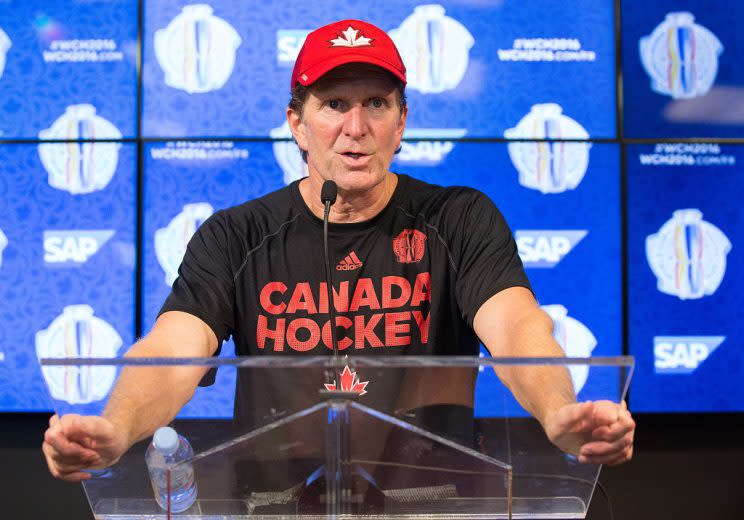
In some ways there’s no precedent for the 2016 World Cup of Hockey. It’s an international tournament like the 1996 event and the 2004 group of games, but it’s a different format. The North American squad has created obstacles for Team USA or Team Canada, which can’t pick top players under the age of 23 like Johnny Gaudreau, Brandon Saad, Connor McDavid or Aaron Ekblad.
Instead of allowing multiple countries to compete, Team Europe has streamlined the process, putting players not from North America, Sweden, Finland, Russia and the Czech Republic into one group.
“Going into this year’s World Cup it’s going to be tighter with the European team, wow they’re going to be tough with the North American young guns group,” Nicholson said. “You’re not going to have a period off or a shift off. If you do, you’ll get knocked right out of the tournament.”
Overall it’s hard to expect success like the 1996 tournament – which was a watershed moment for American hockey. But it’s fair to say the quality of the tournament will create buzz and interest once it’s started.
The League has a different broadcast partner for the event in ESPN, which has generated interest and 90s nostalgia from hockey fans. The NHL has also ramped up its technology for the tournament, saying it will use player tracking to better enhance fan viewing and increase information available about the games and the players.
“From our perspective this really allows fans to quantitatively understand the speed, the skill, the agility required to play the game at the NHL level,” said NHL executive vice president of digital media and strategic planning Stephen McArdle.
Tournaments involving NHL players on North American ice, such as the 1996 World Cup or the 2010 Olympics tend to have a higher entertainment value than events on the bigger international surface.
“There are more quick scoring chances and battles for the puck and more opportunities for all types of players to do well,” Leetch said.
The tournament will also revert back to a best-of-three final, which helped add extra drama to the 1996 event.
“What I really like is whatever team gets to the finals is going to be the best out of three. That adds a little bit of mustard to this tournament. I think Team Europe is going to be great because you have all those teams over there and I think this young team is going to be real good too,” Thornton said. “You have a nice mix and a nice change of who’s going to be there. I think all the countries are going to be great but I think that final, how that’s paired up with two-out-of-three is going to be really cool to watch that.”
Also, there’s no pending lockout, which should give it a leg up on 2004.
There is a belief that the U.S. has to play Canada in the final for the tournament to draw extra interest. That’s still a concern moving forward – but it may not be a necessity like years past, thanks to the increased marketability and popularity of international players with NHL teams. Also, part of the draw of hockey in this format is that several teams can win on any given game.
“Hockey is truly a sport that has five or six dream teams because it’s so international that there are that many teams that expect to win and rightfully expect to win,” Richter said. “Swedes, Finns, Americans, Russians, Canadians, they all have guys with gold medals. It’s not an upset if one of those five teams wins, they were the best team that day, so you’re going to get great competition. You look down the list and there’s not a team that’s not going to be good.”
All the successful ingredients are in place, but the final push comes from the players to make sure the quality of play is top notch. With so much talent amassed across the tournament, it’s hard to see this not being the case.
“I think the goal was to get as many of the best players there, so they’ve accomplished that goal,” Johannson said. “What that does for the competition? The players control that, so I mean we know these guys are going to play and we know it’s going to be executing hockey, but all eight teams are going into it hoping they’re playing in that final. We’re certainly in that boat but we understand everyone feels that way as well.”
– – – – – – –
Josh Cooper is an editor for Puck Daddy on Yahoo Sports. Have a tip? Email him at puckdaddyblog@yahoo.com or follow him on Twitter! Follow @joshuacooper
MORE FROM YAHOO SPORTS



